 W
WAcro dance is a style of dance that combines classical dance technique with precision acrobatic elements. It is defined by its athletic character, its unique choreography, which seamlessly blends dance and acrobatics, and its use of acrobatics in a dance context. It is a popular dance style in amateur competitive dance as well as in professional dance theater and in contemporary circus productions such as those by Cirque du Soleil. This is in contrast to acrobatic, artistic and rhythmic gymnastics, which are sports that employ dance elements in a gymnastics context under the auspices of a governing gymnastics organization and subject to a Code of Points. Acro dance is known by various other names including acrobatic dance and gymnastic dance, though it is most commonly referred to simply as acro by dancers and dance professionals.
 W
WAcrobalance is a floor-based acrobatic art that involves balances, lifts and creating shapes performed in pairs or groups.
 W
WAcrobatics is the performance of human feats of balance, agility, and motor coordination. Acrobatic skills are used in performing arts, sporting events, and martial arts. Extensive use of acrobatic skills are most often performed in acro dance, circus, and gymnastics, and to a lesser extent in other athletic activities including ballet, slacklining and diving. Although acrobatics is most commonly associated with human body performance, the term is used to describe other types of performance, such as aerobatics.
 W
WAdagio is the performance of partner acrobalance poses and associated movements that involve stationary balances by a pair of performers. It is performed in professional circus, in various dance disciplines including acro dance and ballet, in pair skating, and as a hobby in university circus groups.
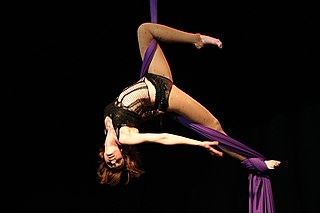 W
WAerial silks is a type of performance in which one or more artists perform aerial acrobatics while hanging from a fabric. The fabric may be hung as two pieces, or a single piece, folded to make a loop, classified as hammock silks. Performers climb the suspended fabric without the use of safety lines and rely only on their training and skill to ensure safety. They use the fabric to wrap, suspend, drop, swing, and spiral their bodies into and out of various positions. Aerial silks may be used to fly through the air, striking poses and figures while flying. Some performers use dried or spray rosin on their hands and feet to increase the friction and grip on the fabric.
 W
WStraps, also known as aerial straps, are a type of aerial apparatus on which various feats of strength and flexibility may be performed, often in the context of a circus performance. It is a cotton or nylon web apparatus that looks like two suspended ribbons. Wrapping the strap ends around hands and wrists, the performer performs holds, twists, rolls and manoeuvres, requiring extreme strength and precision similar to men’s rings in gymnastics. Straps are available in various configurations, including those with various types of loops at the ends and those without loops. A straps act usually includes held poses and postures done on the straps, dance moves performed on the floor away from the straps, partner acrobatics done on and off the straps, as well as having the straps pulled up and let down during the act.
 W
WArtistic cycling is a form of competitive indoor cycling in which athletes perform tricks for points on specialized, fixed-gear bikes in a format similar to ballet or gymnastics. The exercises are performed in front of judges in five-minute rounds by singles, pairs, four- or six-person teams.
 W
WBaton twirling involves using the body to spin a metal rod in a coordinated routine. It is similar to rhythmic gymnastics or color guard.
 W
WCardistry is the performance art of card flourishing. Unlike card magic, cardistry is meant to be visually impressive and appear very hard to execute.
 W
WThe use of chairs as props in acrobatics falls into three broad categories: balancing, vaulting and contortion.
 W
WCigar boxes are rectangular props used in juggling. Wood block manipulation was thought to have started by Japanese prisoners who were given small wood blocks as head rests for sleeping. Cigar box manipulation was developed as a vaudeville act in the United States between the 1880s and 1920s, and was popularized by W. C. Fields. Originally, performers would take actual boxes that cigars were stored in and nail them shut to create their juggling props. Today, cigar boxes for juggling are typically purpose-built, hollow wooden or plastic blocks with suede or foam rubber padding attached to the sides.
 W
WClowns have always been an integral part of the circus, offering a source of amusement for patrons and providing relief from the array of animal acts and performances by acrobats and novelty artistes.
 W
WContact juggling is a form of object manipulation that focuses on the movement of objects such as balls in contact with the body. Although often used in conjunction with "toss juggling", it differs in that it involves the rolling of one or more objects without releasing them into the air.
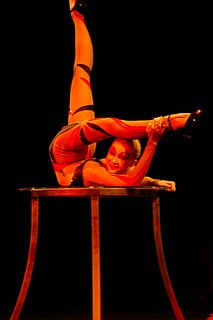 W
WContortion is a performance art in which performers called contortionists showcase their skills of extreme physical flexibility. Contortion acts often accompany acrobatics, circus acts, street performers and other live performing arts. Contortion acts are typically performed in front of a live audience. An act will showcase one or more artists performing a choreographed set of moves or poses, often to music, which require extreme flexibility. The physical flexibility required to perform such acts greatly exceeds that of the general population. It is the dramatic feats of seemingly inhuman flexibility that captivate audiences.
 W
WThe cradle is a type of aerial circus act in which a performer hangs by his or her knees from a large rectangular frame and swings, tosses, and catches another performer. The aerialist being swung is referred to as a flyer, while the one doing the tossing and catching is referred to as a catcher or caster. The flyer usually starts and ends standing on the frame above the catcher. The flyer swings holding on to the catcher's hands, performs releases at the top of the swing, and is re-caught in mid-air.
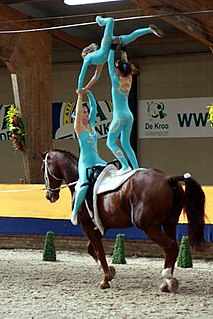 W
WEquestrian vaulting, or simply vaulting, is most often described as gymnastics and dance on horseback, which can be practiced both competitively or non-competitively. Vaulting has a history as an equestrian act at circuses, but its origins stretch back at least two-thousand years. It is open to both men and women and is one of ten equestrian disciplines recognized by the International Federation for Equestrian Sports. Therapeutic or interactive vaulting is also used as an activity for children and adults who may have balance, attention, gross motor skill or social deficits.
 W
WFire breathing is the act of making a plume or stream of fire by creating a precise mist of fuel from the mouth over an open flame. Regardless of the precautions taken, it is always a dangerous activity, but the proper technique and the correct fuel reduces the risk of injury or death.
 W
WFire eating is the act of putting a flaming object into the mouth and extinguishing it. A fire eater can be an entertainer, a street performer, part of a sideshow or a circus act but has also been part of spiritual tradition in India.
 W
WFire performance is a group of performance arts or skills that involve the manipulation of fire. Fire performance typically involves equipment or other objects made with one or more wicks which are designed to sustain a large enough flame to create a visual effect.
 W
WFirewalking is the act of walking barefoot over a bed of hot embers or stones.
 W
WThe flying trapeze is a specific form of the trapeze in which a performer jumps from a platform with the trapeze so that gravity makes the trapeze swing.
 W
WThe Globe of Death is a circus and carnival stunt where stunt riders ride motorcycles inside a mesh sphere ball. It is similar to the wall of death, but in this act riders can loop vertically as well as horizontally. There have been three performance-related deaths recorded between 1949-1997. The only Globe of Death World Record officially recognized by the Guinness World Records is six riders and one person in the center by the Infernal Varanne team on the set of Lo Show Dei Record, in Milan, Italy, on 13 April 2011. It is sometimes the finale of the circus.
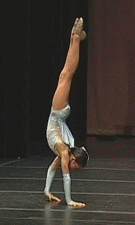 W
WHand walking is an unusual form of human locomotion in which a person travels in a vertically inverted orientation with all body weight resting on the hands. It can be executed with legs fully extended or with variations such as stag, straddle or front splits. Hand walking is performed in various athletic activities, including acro dance and circus acrobatics.
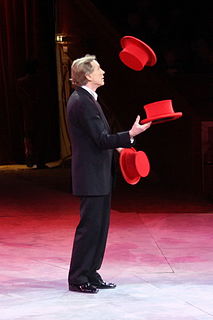 W
WHat manipulation is a form of juggling in which the manipulator performs feats of skill and dexterity using a brimmed hat such as a bowler hat or a top hat as a prop. Tricks can range from rolling a hat up and down the various parts of the body to throwing and catching the hat in amusing ways. Hat manipulation is often comedic in nature. Part of the appeal of the art is in the necessary equipment; all that is needed is a good, heavy, brimmed hat, which can be found at many juggling stores. Famous manufacturers of manipulation specific hats are Nils Poll and Dubé. Hat manipulation is also frequently combined with traditional forms of juggling in order to create more varied acts.
 W
WHot water bottle blowing is the deliberate inflation of a hot-water bottle by blowing. Air is breathed into the bottle until it stretches beyond its capacity and consequently explodes. It is a challenging feat of strength which is included in the Guinness World Records. The challenge is most commonly undertaken by breathing air from the mouth, though it has also been achieved by blowing through the nose. The activity presents a potential hazard for physical injury to eyes and lungs.
 W
WThe "human" cannonball act is a performance in which a person who acts as the "cannonball" is ejected from a specially designed "cannon". The human cannonball lands on a horizontal net or inflated bag placed at the landing point, as predicted by physics. Outdoor performances may aim at a body of water.
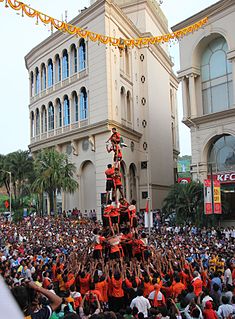 W
WA human pyramid is an acrobatic formation of three or more people in which two or more people support a tier of higher people, who in turn may support other, higher tiers of people. People above the bottom tier may kneel or stand on the shoulders, backs or thighs of the people below them. Typically, the number of people in each tier is one greater than the tier immediately above it, resulting in a triangular structure reminiscent of the formation's namesake.
 W
WImpalement arts are a type of performing art in which a performer plays the role of human target for a fellow performer who demonstrates accuracy skills in disciplines such as knife throwing and archery. Impalement is actually what the performers endeavor to avoid – the thrower or marksman aims near the target rather than at him or her. The objective is to land the throw or shot as close as possible to the assistant's body without causing injury.
 W
WJuggling is a physical skill, performed by a juggler, involving the manipulation of objects for recreation, entertainment, art or sport. The most recognizable form of juggling is toss juggling. Juggling can be the manipulation of one object or many objects at the same time, most often using one or two hands but also possible with feet. Jugglers often refer to the objects they juggle as props. The most common props are balls, clubs, or rings. Some jugglers use more dramatic objects such as knives, fire torches or chainsaws. The term juggling can also commonly refer to other prop-based manipulation skills, such as diabolo, plate spinning, devil sticks, poi, cigar boxes, contact juggling, hooping, yo-yo, and hat manipulation.
 W
WThe kendama is a traditional Japanese skill toy. It consists of a handle (ken), a pair of cups (sarado), and a ball (tama) that are all connected together by a string. On one end of the ken is a cup, while the other end of ken is narrowed down, forming a spike (kensaki) that fits into the hole (ana) of the tama. The kendama is the Japanese version of the classic cup-and-ball game, and is also a variant of the French cup-and-ball game bilboquet. Kendama can be held in different grips, and the tricks and combinations that can be done are limitless. The game is played by tossing the ball into the air and attempting to catch it on the stick point.
 W
WKnife throwing is an art, sport, combat skill, or variously an entertainment technique, involving an artist skilled in the art of throwing knives, the weapons thrown, and a target. In some stage performances, the knife thrower ties an assistant to the target, and throws to miss them.
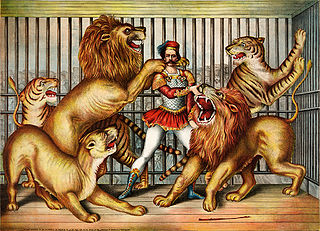 W
WLion taming is the taming and training of lions, either for protection or for use in entertainment, such as the circus. The term often applies to the taming and display of lions and other big cats such as tigers, leopards, jaguars, black panthers, cheetahs, and cougars. People often use lion taming as a metaphor for any dangerous activity. Lion taming occurs in zoos across the world to enable the keepers to carry out medical procedures and feedings.
 W
WMagic, which encompasses the subgenres of illusion, stage magic, and close up magic, among others, is a performing art in which audiences are entertained by tricks, effects, or illusions of seemingly impossible feats, using natural means. It is to be distinguished from paranormal magic which are effects claimed to be created through supernatural means. It is one of the oldest performing arts in the world.
 W
WA skill toy of Asian origin, the meteor consists of a rope, usually between 5 and 8 feet long, with weights attached to either end. Tricks are performed by swinging, wrapping and throwing the meteor about the body.
 W
WPlate spinning is a circus manipulation art where a person spins plates, bowls and other flat objects on poles, without them falling off. Plate spinning relies on the gyroscopic effect, in the same way a top stays upright while spinning. Spinning plates are sometimes gimmicked, to help keep the plates on the poles.
 W
WA Risley or Risley act is any circus acrobalance posture where the base is lying down on their back, supporting one or more flyers with their hands, feet and/or other parts of the body; spinning a person or object using only one's feet.
 W
WThe rolling globe or walking globe is a circus skill in which a performer balances atop a large sphere. Various gymnastic or juggling stunts may be performed while the performer moves and controls the position of the ball with their feet and/or hands.
 W
WRoman ladders are an equilibristic circus skill where four or more people perform acrobatics on specially made ladders. The performers in the middle push the ladders out, while the performers on the outside of the ladders perform various poses and tricks.
 W
WRope-dancing is the general art and act of performing on or with a rope.
 W
WRoustabout is an occupational term. Traditionally, it referred to a worker with broad-based, non-specific skills. In particular, it was used to describe show or circus workers who handled materials for construction on fairgrounds. In modern times it is applied to rural employment, such as those assisting sheep shearing, and positions in the oil industry.
 W
WThe Russian bar is a circus act which combines the gymnastic skills of the balance beam, the rebound tempo skills of trampoline, and the swing handstand skills of the uneven bars and the parallel bars. The bar itself is a flexible vaulting pole around 4 to 4.5 metres long, typically made of fiberglass; three vaulting poles may also be fastened together to create a flexible beam. The act involves two bases balancing the bar on their shoulders, and one flyer standing on the bar, with the flyer bouncing and performing aerial tricks and landing on the bar.
 W
WA Russian swing is a large, floor-mounted swing which is sometimes used in circus performances to make impressive high acrobatic jumps.
 W
WIn North America, a sideshow is an extra, secondary production associated with a circus, carnival, fair, or other such attraction.
 W
WSlacklining refers to the act of walking, running or balancing along a suspended length of flat webbing that is tensioned between two anchors. Slacklining is similar to slack rope walking and tightrope walking. Slacklines differ from tightwires and tightropes in the type of material used and the amount of tension applied during use. Slacklines are tensioned significantly less than tightropes or tightwires in order to create a dynamic line which will stretch and bounce like a long and narrow trampoline. Tension can be adjusted to suit the user, and different webbing may be used in various circumstances.
 W
WSlackwire is an acrobatic circus act that involves the balancing skills of moving along a flexible, thin wire suspended in the air, connected to two anchor points. Slackwire is not to be confused with slacklining.
 W
WStatic trapeze, also known as fixed trapeze, is a type of circus art performed on the trapeze. In contrast to the other forms of trapeze, on static trapeze the bars and ropes mainly stay in place.
 W
WIn the 19th century, the term strongman referred to an exhibitor of strength or similar circus performers who performed feats of strength. More recently, strength athletics, also known as strongman competitions, have grown in popularity. These competitions are now composed of a variety of events in which competitors have to move the highest weights possible, the winner being the one having the highest tally across all events.
 W
WSword swallowing is a skill in which the performer passes a sword through the mouth and down the esophagus to the stomach. This feat is not swallowing in the traditional sense. The natural processes that constitute swallowing do not take place, but are repressed to keep the passage from the mouth to the stomach open for the sword. The practice is dangerous and there is risk of injury or death.
 W
WIn circus and vaudeville acts, a target girl is a female assistant in "impalement" acts such as knife throwing, archery or sharpshooting. The assistant stands in front of a target board or is strapped to a moving board and the impalement artist throws knives or shoots projectiles so as to hit the board and miss the assistant. The image or character of the target girl has become an icon in fiction and visual media.
 W
WThe teeterboard is an acrobatic apparatus that resembles a playground seesaw. The strongest teeterboards are made of oak. The board is divided in the middle by a fulcrum made of welded steel. At each end of the board is a square padded area, where a performer stands on an incline before being catapulted into the air. The well-trained flyer performs various aerial somersaults, landing on padded mats, a human pyramid, a specialized landing chair, stilts, or even a Russian bar.
 W
WTightrope walking, also called funambulism, is the skill of walking along a thin wire or rope. It has a long tradition in various countries and is commonly associated with the circus. Other skills similar to tightrope walking include slack rope walking and slacklining.
 W
WToss juggling is the form of juggling which is most recognisable as 'juggling'. Toss juggling can be used as: a performing art, a sport, a form of exercise, as meditation, a recreational pursuit or hobby.
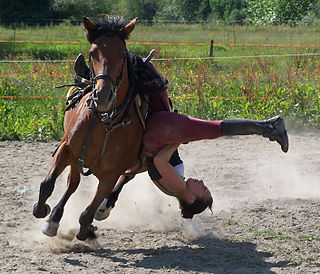 W
WTrick riding refers to the act of performing stunts while riding a horse, such as the rider standing upright on the back of a galloping horse, using a specially designed saddle with a reinforced steel horn, and specialized kossak loops for hands and feet. The horse is likewise galloping free. Trick riding is NOT the same as equestrian vaulting which is an internationally recognized competitive sport, governed by the Federation Equestre Internationale (FEI).
 W
WTrick roping is an entertainment or competitive art involving the spinning of a lasso, also known as a lariat or a rope. It is particularly associated with Wild West shows or Western arts in the United States.
 W
WTwirling is a form of object manipulation where an object is twirled by one or two hands, the fingers or by other parts of the body. Twirling practice manipulates the object in circular or near circular patterns. It can also be done indirectly by the use of another object or objects as in the case of devil stick manipulation where handsticks are used. Twirling is performed as a hobby, sport, exercise or performance.
 W
WThe Ursari or Richinara are the traditionally nomadic occupational group of animal trainers among the Romani people.
 W
WVentriloquism, or ventriloquy, is a perfomance act of stagecraft in which a person creates the illusion that their voice is coming from elsewhere, usually a puppeteered prop known as a "dummy". The act of ventriloquism is ventriloquizing, and the ability to do so is commonly called in English the ability to "throw" one's voice.
 W
WWheel gymnastics is a form of gymnastics that originated in Germany. Wheel gymnasts do exercises in a large wheel or hoop known as the Rhönrad, gymnastics wheel, gym wheel, or German wheel, in the beginning also known as ayro wheel, aero wheel, and Rhon rod.
 W
WThe Wheel of Death, in the context of acrobatic circus arts, is a large rotating apparatus on which performers carry out synchronized acrobatic skills. The "wheel" is actually a large space frame beam with hooped tracks at either end, within which the performers can stand. As the performers run around on either the inside or outside of the hoops, the whole apparatus rotates. Performers also perform balancing skills with the wheel in a stationary position.
 W
WA yo-yo is a toy consisting of an axle connected to two disks, and a string looped around the axle, similar to a spool. It is an ancient toy with proof of existence since 500 BCE. The yo-yo was also called a bandalore in the 17th century.